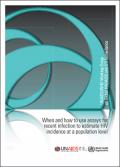Publications - Released in 2011
It is more than a decade since the first report appeared of a laboratory test aimed at distinguishing recently acquired HIV infections from infections of a longer duration. Several expert groups have now developed tests of this kind, based on the underlying principle that the immunological response to HIV infection evolves for a number of months following infection, and that it is possible to identify a marker for the early period. This marker eventually disappears and can therefore serve as an indicator of recent infection. For the purpose of these tests, “recent” generally means a period of up to a year after infection has been acquired.
The document reviews the public health importance of estimating the HIV incidence in populations, and the various methods that have been used for this purpose. It provides guidance on the way in which laboratory tests for recent HIV infection may be used to estimate HIV incidence in populations, particularly with regard to sampling designs, sample size and the statistical analyses that should be employed.
Downloads
Organizations
- Joint United Nations Programme on HIV/AIDS (UNAIDS)
- World Health Organization (WHO)






